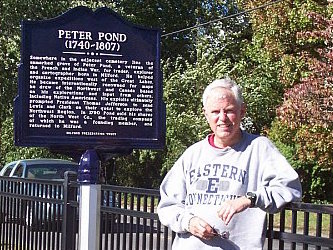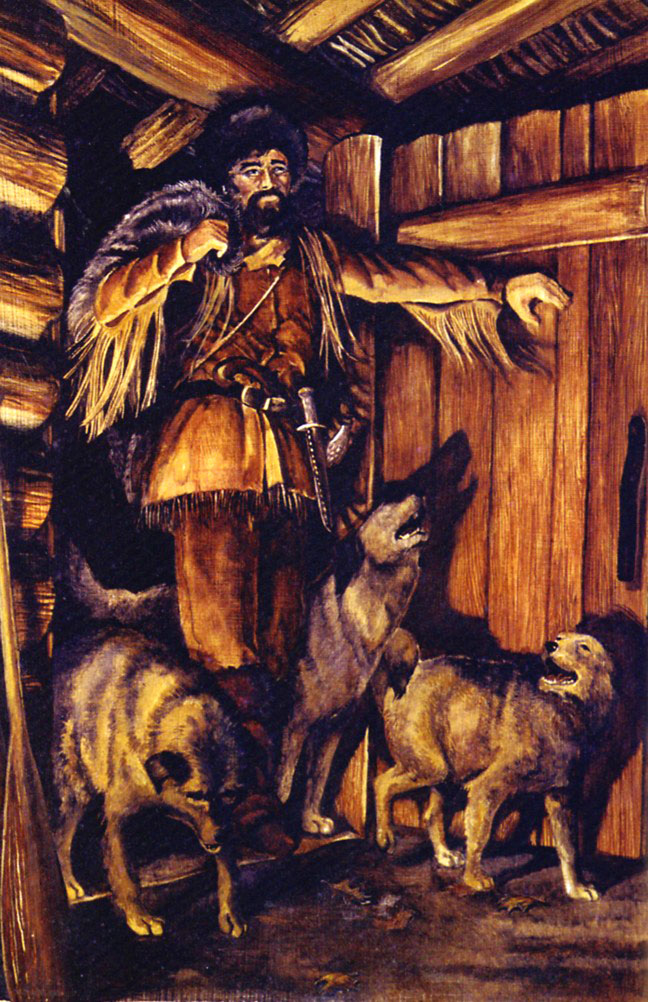Peter Pond newsletter :: July 2003 :: #16
PLANNED ARCHEOLOGICAL DIG FOR PETER POND
I hope everyone has had an enjoyable patriotic celebration in our respective North American nations: July 1 Dominion Day in Canada, July 4 Independence Day in USA.
It's time to make another auspicious announcement in the life of Peter Pond Society. I can finally state, with receipt of written permission, that an archeological dig is set to take place by summer's end toward ascertaining the location of Peter Pond's grave.
As the day draws closer - probably sometime in late August - I have to admit I feel funny going about this ie. digging up a grave and maybe confronting a skeleton which may not be him. But the fact remains I am driven by a sense of history and an obligation set things right for a person who remains controversial to this day, who had both pluses and minuses going for him, but still did some amazing things and deserves more recognition than he has received, at least in this country and his hometown. That said, I will get on to particulars.
The letter of permission below is dated July 1, 2003 from Robert D. Beard, Milford Cemetery Association president. It is addressed to Connecticut State Archeologist Nicholas Bellantoni who will be conducting the work with crew of about a half dozen student volunteers. Bellantoni's proposal showing his interest in the project is found in Peter Pond Society 15. Beard's letter mentions the work taking place in July, but that date has been changed. Bellantoni says he will provide certificate of insurance once he receives the permission letter.
This approval follows a May 13 slide presentation to the cemetery board (Pres. Robert Beard, V.P. James Beard, Ray Oliver, board attorney Steve Rogers and cemetery director Ray Scholl) in which Nick showed his work on three past similar projects. He has worked on 150 projects involving skeletal remains since the 1970's. Of the three shown, one dealt with the 100-year-old body of a 14-year-old girl found during a construction project, another on the excavation of a family tomb containing about seven coffins circa 1700's that had fallen in and needed to be refurbished, and the exhumation of a Hawaiian man who died with a marker in 1818 in a remote rural lot and the family wanted him transported back to Hawaii, which happened.
In our case, we don't have a marker, but indications of disturbed earth found through a ground radar scan near his mother's headstone that could be two unmarked graves. We have family permission to proceed. It's a matter of checking those two apparent graves to see what's there, which should take about four days.
Once down to about five feet, you can start finding the outline of a coffin, if one was used, and maybe a skeleton. How dry and acidic the soil is determines how well a skeleton can be preserved. If there is a coffin, identification can be made through brass tacks in the wood marking the deceased's initials and age at death. If no coffin, forensic analysis comes in, ie if the skeleton appears around age 67, that he died of consumption and appears to be a large robust male who led an active life. DNA testing will not be used, too expensive at around $1,000. The remains will not be moved, just examined and reburied. We'll decide at that time how definite we can make the identification. As I said before, it would help if we found an Indian artifact unique to Western Canada. Someone also remarked even if we never find him or can't confirm identification, some kind of permanent marker might still be in order.
You've probably read more about the slide presentation than you'd like to know. A little more discussion and fine tuning led to the letter at the top of this article.
QUALIFYING FOR VETERAN'S GRAVE MARKER
There are similar occurrences to this grave search. J.B. Tyrell located David Thompson's unmarked grave in Montreal in 1923 (DT died too poor to afford one but Tyrell was directed to it by the family) and made sure he got a proper marker in 1926. I just heard plans are afoot for a DT bicentennial in Canada's Pacific Northwest in 2007.
Then there was a recent news item about exhuming the bones of none other than Christopher Columbus. It seems authorities are not sure whether he's in Spain or Santo Domingo, so they exhumed both places toward conducting DNA testing.
I would like to get a marker for Peter Pond if we are successful. I think we can get it for free if we go through the federal government, which I might have mentioned before. If the feds don't agree or if we're not successful, maybe we can just raise money, but that's for another discussion.
A free grave marker goes to any USA war veteran. Pond fought in the French and Indian War but that would not qualify him since it was before USA existed. He was in Canada for much of the American Revolution. But on return to Milford in 1790, his reputation was apparently known enough to have War Secretary Henry Knox send him on a secret mission to quell an Indian uprising in the Niagara area in 1792. All indications are that Pond went, was unsuccessful and returned home. But the fact that he was sent on a secret mission as a spy by the war secretary might fill the bill.
Thanks to Peter Pond Society member John C. Jackson for alerting us of page 227 of this document with instructions for "Captain" Pond and William Steedman to conduct the mission.
Here is how one can qualify for a federal marker.
I think Peter Pond could qualify as follows:
"(2) A Commissioned Officer who served before July 29, 1945, and;
(a) Was assigned to an area of immediate military hazard while in time of war, or of a Presidentially declared national emergency as determined by the Secretary of Defense…"
MARY QUAYLE INNIS
Finally, from to two interesting messages in the Peter Pond Society guest book.
One is from David Black, communications professor at Wilfrid Laurier University, Waterloo, Ontario. He is writing an academic article on Mary Quayle Innis, an American born writer and popular historian who met and married Harold A. Innis while both were studying at University of Chicago. H.A. Innis, as many of you must know, wrote the first of only two books devoted solely to Peter Pond, the other being by Yale Prof. Henry B.Wagner in 1955. I asked more about Innis (1894-1952) and found while originally an economic historian, he was able to transfer parallel theories from that specialty into communication studies that strongly influenced fellow Canadian Marshall McLuhan (1911-1980), known for his famous book, "The Medium is the Massage." I am told "Massage" is not misspelled. Innis, wounded in World War I, canoed through Northwest Canada in the late 1920's and wrote "The Fur Trade in Canada" published in 1930 and since reprinted several times. His book "Peter Pond: Fur Trader and Adventurer," came out the same year and never reprinted, as a way to better examine the fur trade "through the life of one extraordinary person deeply involved in a particular commodity," Black said. Innis taught at University of Toronto from 1920 to his death in 1952. See my Peter Pond Society bibliography for more information on the two books. The only Innis biography is Donald Creighton's 1957 book, "Harold Adams Innis: Portrait of a Scholar." Another WLU communications professor, Dr. Paul Heyer, is currently working on an Innis biography due out this fall. I must add WLU has become a great resource with the input of Black, Heyer and my main Canadian Peter Pond expert, Barry Gough. Here is something on Innis.
FUR TRADER FAMILIES
Another message is from Betty Deck of Chetwynd, British Columbia. She is looking for families of fur traders who may wish to be included in her part of Canada's Historical Garden Trail. Have a look and see what you think of her pretty Memory Lane International Friendship Gardens based on 1800's Victorian gardens.
click on "The Fur Traders Mile."

That should be enough for now. Until later.
Au revoir,
Bill
website design by Daniel Ortoleva

